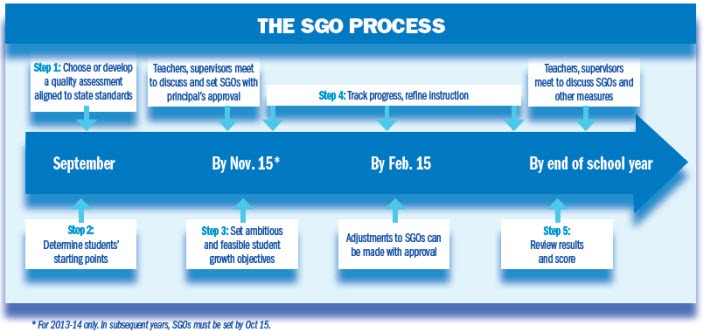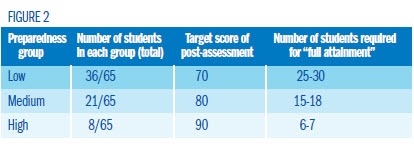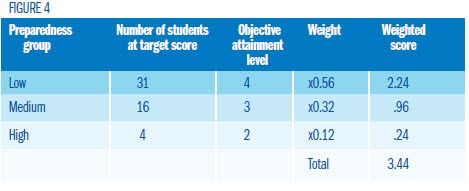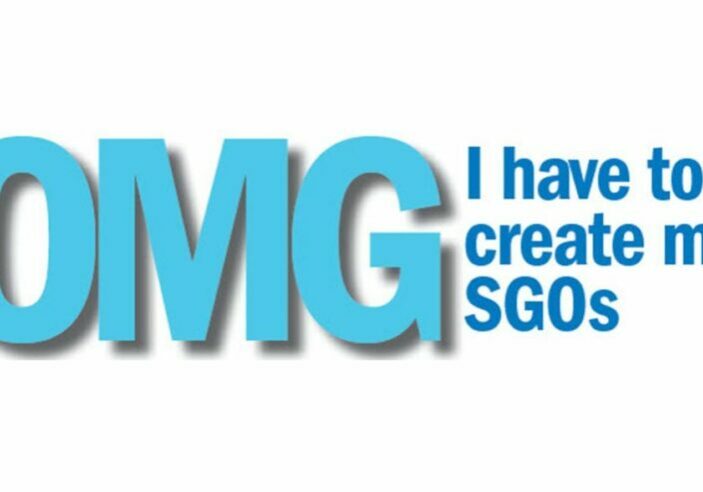by Richard Wilson, NJEA staff
It may seem daunting, but done properly, the process can empower teachers to set meaningful goals for students and use those goals as evidence of learning
Good teachers know their content, understand what they want students to learn by year’s end, take stock of the students that enter their classrooms in September, and then create a plan to get their students to that final goal line. This process is exactly what occurs when developing student growth objectives. In its simplest form, a student growth objective (SGO) is a long-term academic goal, set by a teacher in collaboration with a supervisor. What is new is how students succeed in reaching that goal will be calculated into a teacher’s summative evaluation.
The 2012 tenure and evaluation law, also known as TEACH NJ, required that teacher evaluation be based on both teacher practice, through the use of an approved instrument, and student achievement. Within the student achievement side of the equation was a requirement for multiple measures of student growth. The SGO is a process to fit that requirement.
This school year, all instructional teaching staff who receive a student growth percentile score based on the NJASK (grades 4-8 language arts and math teachers) will be required to complete at least one SGO. All other teaching staff members will be required to complete two SGOs. Whether a teacher completes one or two, the SGOs will account for 15 percent of the total summative evaluation.
There are five steps to developing a quality student growth objective, and each should be completed within a particular time frame. The steps are:
- Choosing or developing a quality measurement tool that is aligned to applicable standards.
- Determining students’ starting points.
- Setting ambitious, yet achievable student growth objectives.
- Tracking progress and refining instruction accordingly.
- Reviewing results of assessments and scoring the SGO.
Choosing a measurement tool
BY SEPTEMBER
Before developing an objective, a teacher must identify the most important content or skills from a course or class. SGOs can be created around a summary of content from a course, using something like a final assessment, or can reflect “power standards.” SGOs can also be written around a specific set of skills that a group of students need to successfully complete the course.
Once the teacher establishes what will be measured, the next step is to determine how it will be measured. The measurement tool can take a variety of formats, depending on the nature of the course or class. For example, you may consider a traditional assessment, a collection of work in a portfolio, or a performance assessment.
Choosing or developing an assessment can be done prior to the start of the school year, once a teacher knows his or her teaching assignment. This decision can be made collaboratively with colleagues who teach the same subject or grade level and would be an ideal topic for a professional learning community. When choosing or developing an assessment it is important to keep in mind that it should include a level of rigor that is appropriate to the content of the course.
This assessment does not have to be something brand new or something that is purchased. There is no need to reinvent the wheel. If a district or school has an assessment or a set of assessments that it has used, it makes sense to continue to use these and simply apply them to this new process. It is crucial to remember, however, that the assessment cannot cover the entire year and is administered late in the year, the SGO might not be scored until the beginning of the next school year. To avoid this, an assessment can be given earlier and the SGO can be scored at the annual review conference. Another important point is that the NJASK cannot be used as an assessment for SGO purposes because it is used to determine a student growth percentile.
A traditional assessment could be a paper/pencil task that is developed or purchased from a publisher. It could be something as formal as an AP exam or as informal as a common assessment developed within a department or a professional learning community.
For some course content, it might make more sense to collect student work over the course of a school year in a portfolio and use that as the final assessment. For example, if a teacher is working to improve writing across several genres, the teacher could collect writing samples from before and after the teaching of a unit on each of those genres, looking for growth on an agreed-upon writing rubric. Portfolios are often a more authentic demonstration of student work, without the pressure of a high-stakes test. A challenge around the use of portfolios is the need for a very clear, agreed-upon rubric to assess student work prior to the beginning of the collection of work.
Performance assessment is another option. With the performance assessment, students show they have mastered content through the completion of a task or set of tasks. These assessments could include the performance of a lab in one of the sciences, sight reading performances in music, a demonstration of physical education skills, or a persuasive speech in a public speaking class. Such assessments might lend themselves to areas such as the practical and performing arts, physical education, or other areas where students can show the attainment of a set of skills in ways that do not include paper/pencil tasks.
No matter which type of assessment you choose, it is important that you and your supervisor agree on the type of assessment early in the school year. The more clearly everything is spelled out in the beginning of the SGO process, the less chance there is for disagreement about the results in the spring.
Determining starting points
BY SEPTEMBER
Since an SGO is developed to show actual growth of students, and is not just an arbitrary learning goal, it is important to have a firm understanding of just where students are performing at the beginning of the school year. One of the reasons that SGOs are not expected to be completed until Nov. 15 (Oct. 15 in subsequent years), is to give teachers sufficient time to get to know the students in their care.
The simplest way to collect some of this data about your students is through a pretest or assessment of some sort, but there are other ways to find out what students already know and/or can do. You can look at student grades from a prerequisite course, examine scores from the previous year’s assessments, look through past portfolios of student work, or discuss a student’s progress with the previous year’s teacher or team of teachers.
There is also that qualitative, intuitive sense that teachers often get in the first few weeks of school that helps them informally assess the kind of class they have before them. The quality of questions that students ask, their performance on tasks early in the year, perhaps their performance on early quizzes or a first chapter or benchmark test all might be used to get a sense of how they will perform for the rest of the year.
Your goal is to collect the highest quality data possible, with an emphasis on more data rather than less. The use of a single pretest might not be sufficient when predicting a student’s performance in a high-stakes environment.
Creating the student growth objective
BY NOV. 15*

Once you have created an assessment to measure student growth and gathered enough information to make sufficient judgments about students’ current academic performance, the next step is to create the SGO. There are four types of SGOs: a general goal, a general-tiered goal, a specific goal focused on a group of students, or a specific goal based on particular content or skills from the class.
To develop a general SGO, determine a score on the final assessment that indicates considerable learning of the most important content in the course. Next, using what you’ve learned about the students’ starting points, estimate the number of students who can reasonably be expected to reach that mark. The next step is to determine the percentage of the class that number of students represents, and create a 10-15-percent range around that number.
For example, a science teacher has 65 students across three sections of the same course. He determines that a score of 80 percent on his final assessment will indicate significant learning in this course. After taking into account where his students are at the beginning of the year, he and his supervisor agree that if at least 70 percent of his students reach this score, his class will have shown significant growth. This would result in the teacher reaching full attainment of his SGO, and from an evaluation standpoint, he would earn a 3 (full) on a 1-4 scale. By adding and subtracting 15 percent, they can determine an exceptional score (4), a partial score (2) or an insufficient score (1). This information is shown in the table below:

The chart identifies exactly how many students have to perform at each level to determine a teacher score. If 45-54 students score at least 80 percent on the final assessment, the teacher receives an attainment score of 3. If more than 54 students score an 80 percent, the teacher receives a 4. The chart also shows the results that would generate a score lower than 3.
A weakness of this method is that it assumes that all students are beginning the year with roughly the same skills, which is seldom the case. A second type of SGO, the tiered method, helps to deal with this situation.
In the tiered method, students are grouped at the beginning of the year, based on the information gathered by the teacher, into a low group, a medium group, and a high group. Since students are beginning the year in different places, they might all grow a significant amount, yet show different scores on the final assessment. In the example above, a low group might be expected to score 70 percent on the final assessment, the medium group 80 percent, and the high group a 90 percent. In the chart below, the hypothetical teacher has grouped his students, determined how many students are in each group, and set goals for them.
Using the 15-percent span for each of the teacher attainment scores, the teacher and supervisor agree on the following:

There are two ways to score this type of SGO. The first is simply to assign a score for each of the subgroups based on its performance on the final assessment. Once the teacher determines the score for each subgroup, a simple mean is found by adding the three scores and dividing by three.
For example, the students in the low group showed a great deal of growth, giving the teacher an attainment score of 4. The students in the medium group did well, and the teacher scored a 3, and the high group of students did not do as well as expected, resulting in a score of 2. In the simple method of scoring, the teacher’s scores of 4+3+2 are added and then divided by three, resulting in a final score of 3.
The scoring above does not take into account the size differences of each group. A second, more complex “weighted method” adjusts scoring to account for these differences. To do this, the teacher would determine the percentage of students in each subgroup and then weigh the scores of each subgroup by multiplying the teacher attainment score by the percentage of students in the group. The table below shows the group of students in the table above with the same scores, but this time with the size of the group taken into consideration:

Each of the scores has been weighted based on the number of students in the group, and, in this case, because the low group is a larger percentage of the class and the high group was a smaller percentage, the scoring works in the teacher’s favor, and the teacher score results in a 3.44.
SGOs can also be more specific. They can be geared to a particular population in the class or be developed around specific skills or course content. In an inclusion class, a specific SGO could be geared to special education or ELL students. It might also address the needs of a group of students struggling with some piece of the content, students who came without prerequisite skills, or more advanced students.
An SGO might also be written around specific course content or skills. Some schools have focused on “power standards” that might be reflected in an SGO.
One of the strengths of the SGO process is that it has been developed with broad rules so that it can address the needs of a wide range of settings, students, and content across the state of New Jersey.
Tracking progress
BY FEB. 15 AND THROUGHOUT THE YEAR
Once again, the next step of the SGO process is to do what good teachers naturally do. This includes monitoring student progress by using solid formative assessment and adjusting instruction accordingly.
If you suspect that your students are not progressing in a way that will lead to the achievement of the SGO, there is an opportunity to revise it. This must be done by Feb. 15, and requires the signature of the chief school administrator (superintendent), so you need to be aware of progress towards the goal. You will need to explain to the supervisor the conditions that might have led to a need for a change. Also, be prepared to list any supports you will need from the school district to help students attain success. Such requests should be documented in case they are needed at the end of the year.
Reviewing results
BY END OF SCHOOL YEAR
Once the final assessment has been scored, it is the responsibility of the supervisor to score the SGO, but there is no reason this should not be a collaborative event. This can be done as part of the annual summative conference.
You should calculate your own score prior to any meeting with a supervisor. If using a tiered SGO, score using both methods and be ready to advocate using the score that works to your best advantage.
If you have one SGO, this score will determine 15 percent of your final summative score. If you have two SGOs, each one is scored and the average of the two becomes your SGO score and accounts for 15 percent of the final summative evaluation.
Opportunities and challenges
Because it is a new process, with very broad guidelines, the development of student growth objectives offers both opportunities and challenges.
Challenges include the fact that, in spite of their educational value, SGOs are tied to a high-stakes evaluation system and misinformation combined with misunderstanding can lead to unintended negative consequences. Teachers and local associations will need to be vigilant in advocating for SGOs that make sense and are tied to individual teachers based on specific teaching assignments, as opposed to imposed general SGOs across grade levels or content areas.
However, there are also opportunities to advocate for a collaborative process, one in which teachers take greater control in setting goals and determining priorities based on the students who come into their classrooms. Implemented properly, the SGO process can empower teachers to set meaningful goals for their specific students and use those goals as evidence of the important impact they have on their students’ learning.
Richard Wilson is an associate director of professional development and instructional issues at NJEA.
